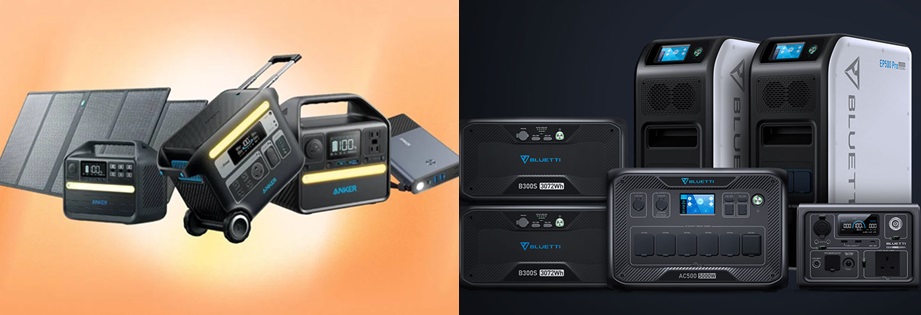When it comes to portable power stations, Anker and Bluetti are two prominent brands known for delivering reliable and efficient solutions. Both brands offer a range of power stations catering to different needs, from entry-level to top-range models. In this comprehensive comparison, we’ll analyze and compare various models from Anker and Bluetti, focusing on key features, specifications, and pricing.
To help you pick the ideal product for your needs, this comparison article should come in handy. I have compared the brands directly, and then gone further to analyze individual products.
And since I’ve covered multiple price ranges, that should make it easier to make your pick.
Brand Comparison: Bluetti vs Anker
Both Bluetti and Anker stand out as reputable choices in the portable power station market, each with its own set of distinctive features. Let’s delve into the specifics of each brand to help you make an informed decision.

Bluetti
Established in 2019, Bluetti, a Las Vegas startup, has swiftly gained recognition for its comprehensive range of power solutions, including solar generators and power banks. Despite being a relatively new player in the industry, Bluetti has garnered positive reviews, reflecting the success of its product lineup.
Bluetti’s solar generators are known for their feature-rich designs, offering expansion options and a variety of practical accessories. Affordability is a key selling point for Bluetti products, evident from the numerous positive reviews on platforms like Amazon. The brand’s products are readily available on its official website, Amazon, and other popular retailers such as Home Depot and Lowes.
Anker
Anker, a well-established player in the tech industry, brings its expertise to the portable power station market. Renowned for quality electronic accessories, Anker provides a diverse range of power solutions. With a history dating back before Bluetti’s entry into the market, Anker has a proven track record of delivering reliable and efficient products.
Anker’s portable power stations are known for their robust build and innovative features. The brand’s reputation for delivering high-quality electronics extends to its power solutions. Anker products are widely available on its official website, Amazon, and various other retailers.
They have a brand reputation to maintain and thus, you can expect high-quality batteries as well as after-sales support.
With brand comparison out of the way, it’s time to have a quick peek at the products that I have compared in this article:
At a glance,
I’ve broken down the comparisons using the following criteria:
- Package content (what’s in the box)
- First impressions
- Portability
- Battery capacity & power
- Recharge times
I’ve also included a verdict at the end of every comparison, highlighting the best product for specific needs. So be sure to read that part too.
Time to dive in!
1. Entry Level: Anker 521 vs. Bluetti EB3A – (priced around $250)

The entry-level segment sets the foundation for evaluating these brands’ offerings. Anker’s 521 provides a balanced power output at 200W, coupled with a 256Wh capacity. In contrast, Bluetti’s EB3A offers a higher power output of 600W but with a slightly lower capacity of 268Wh. The pricing difference of $80 suggests a trade-off between power output and capacity. The article will delve into the implications of this trade-off, considering factors like portability, charging options, and overall value for money.
| PREVIEW | PRODUCT | |
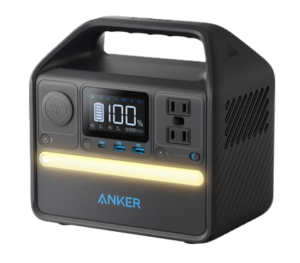 |
Anker 521 | See on Anker |

|
Bluetti EB3A | See on Bluetti |
What’s in the Box?
Anker 521
- One Anker 521 power station
- One car charging cable
- One DC adapter
- One user guide
Bluetti EB3A
- One EB3A power station
- One solar charging cable
- One AC charging cable
- One QC card
- One warranty card
- One user manual
First impressions
Upon initial inspection, a noticeable distinction in design emerges between the two power stations straight out of the box. The Anker 521 presents a sleeker and more contemporary aesthetic, highlighting the significance of design. However, as the saying goes, looks aren’t everything. In terms of dimensions, the Bluetti EB3A is slightly wider and taller.
Further differentiating the two, a comparative analysis of their features is outlined in the following table:
| Anker 521 | Bluetti EB3A | |
| Weight | 9.57 lbs (4.34 Kgs) | 10.14 lbs (4.6kgs) |
| Size (LxWxH) | 8.5 x 8.32 x 5.67 in | 10.04 x 7.09 x 7.20 in / 25.5 x 18.0 x 18.3 cm |
| USB-A Output | 2 Ports (5V, 3.6A / 2.4A Max for each port) | 2 ports: (5V, 3A each) |
| USB-C Output | 1 Port (60W Max) | 1 port: 100W max |
| Car Charger Output | 1 Port: 12V, 10A | 1 port: 12V, 10A |
| AC Output | 2 Ports: 110V, 1.82A (50Hz/60Hz, 200W max continuous) | 2 ports: 120V, 5A / 220-240V, 2.6A (600W max continuous, 1200W surge peak) |
| Lifecycle | 3000 cycles to 80%+ capacity | 2500+ cycles to 80% capacity |
| Warranty | 2 yrs full device warranty | 2 years full device warranty |
Portability
If your primary consideration is portability, the Anker 521 is an excellent choice. Weighing in at 9.57lbs, it is slightly lighter than the Bluetti EB3A, which comes in at 10.14lbs. Additionally, the Anker 521 boasts a more compact frame for added convenience.
Battery capacity & power
Undoubtedly, two of the most crucial factors to consider when choosing a battery pack are its capacity and surge power rating. Upon examining the data presented in the table below, it becomes evident that the Anker 521 lags behind the Bluetti EB3A in both capacity and surge power. This significant difference implies that users with a priority on maximizing energy storage should opt for the Bluetti EB3A.
| Anker 521 | Bluetti EB3A | |
| Battery Capacity | 256Wh | 268.8Wh |
| Max continuous Power | 200W | 600W |
| Surge Power | 450W | 1200W |
| Operating Temperature | 32°F-104°F / 0°C-40°C | -4°F – 104°F / -20°C – 40°C |
| Lifecycles | 3000 cycles to 80%+ capacity | 2,500 cycles to 80% original capacity |
As illustrated above, the Bluetti EB3A surpasses the Anker 521 in both battery capacity and surge power. Here’s a breakdown of the key features:
Recharge times
The amount of time it takes to juice up your battery is just as important as the capacity. After all, what’s the point of having a high capacity if it takes too long to recharge?
Here’s a quick summary of the time it takes to recharge these two power stations:
| Anker 521 | Bluetti EB3A | |
| AC Adapter | 2.5 hrs or less (0% – 80%) | 1.3-1.8 hrs (350W) / 1.5-2.0 hrs (268W) |
| Solar Recharge | 4.1 hrs (0% – 100%) | 1.8-2.0 hrs (200W) |
In summary, when comparing recharge times, the Bluetti EB3A stands out as a considerably faster and more efficient choice than the Anker 521, ensuring users can get back to using their power station more swiftly.
Verdict: Bluetti EB3A Surpasses Anker 521 in Entry-Level Power Stations
In the comparison between the Anker 521 and the Bluetti EB3A in the entry-level power station category, the Bluetti EB3A clearly emerges as the frontrunner. Despite a marginal price difference of $80, the Bluetti EB3A offers a substantial boost in power output at 600W compared to Anker’s 200W, making it a more robust choice for users requiring ample energy reserves. The Bluetti EB3A’s superior battery capacity (268.8Wh) and surge power (1200W) further solidify its position as the preferred option, especially for those prioritizing maximum energy storage and versatile power capabilities.
Beyond power metrics, the Bluetti EB3A showcases efficiency in recharge times, outperforming the Anker 521 in both AC adapter and solar recharging. This efficiency ensures users can quickly replenish their power station, underscoring the Bluetti EB3A as a well-rounded solution. While the Anker 521 may appeal to those prioritizing design and slightly lighter portability, the Bluetti EB3A stands out as a comprehensive choice, delivering superior performance and value for users in need of a reliable entry-level power station.
2. Low Range – Anker 535 vs Bluetti EB55 (priced around $400)

For individuals requiring extended backup power beyond just a few hours, the low range becomes indispensable. In this category, a detailed comparison between the Anker 535 and the Bluetti EB55 provides valuable insights. The Anker 535 and Bluetti EB55 cater to users with higher energy demands, offering enhanced capacity and power options.
| PREVIEW | PRODUCT | |
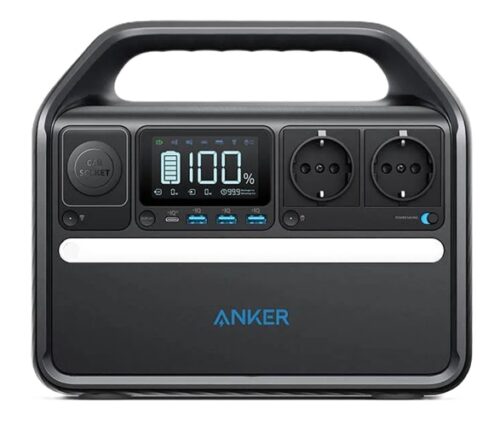
|
Anker 535 | See on Anker |
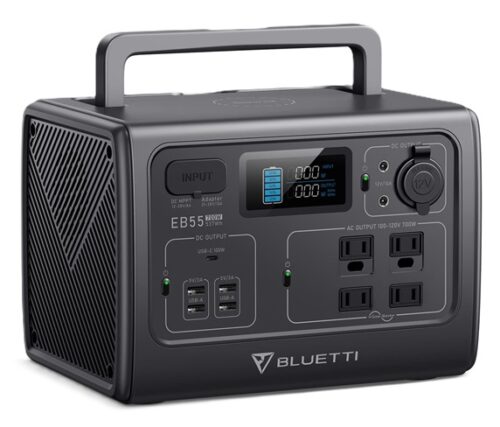
|
Bluetti EB55 | See on Bluetti |
What’s in the Box?
For the Anker 535:
- One Anker 535 portable power unit
- One AC adapter
- One car charger
- One user guide
Bluetti EB55:
- One Bluetti EB55
- An AC charging cable (2 parts: adapter plus charging cable)
- One solar charging cable
- One Car charging cable
- One warranty card
- Quick start guide
First Impression
Initial impressions reveal that, akin to the previous category, Bluetti maintains an advantage in design and build quality. The Anker, while boasting a slightly lighter and more portable design, emphasizes the subjective nature of preferences in this regard. Bluetti continues to present a compelling case for aesthetics and construction, leaving the ultimate choice between the two to individual tastes and priorities.
| Anker 535 | Bluetti EB55 | |
| Weight | 16.75 lbs. (7.60 Kgs) | 16.5 lbs (7.5 kgs) |
| Size (LxWx H) | 11.5 x 9.9 x 7.4 in | 10.94 x 7.87 x 7.79 in |
| USB-A Output | 3 Ports: (5V, 7.2A / 2.4A Max for each port) | 4 Ports: (5V, 3A each) |
| USB-C Output | 1 Port (60W Max) | 1 Port: (100W Max) |
| Car Charger Output | 1 Port: 12V, 10A | 1 Port: 12V, 10A |
| AC Output | 4 Ports: 110V, 4.54A (50Hz/60Hz, 500W max continuous) | 4 Ports: 100-120V, 20A (700W total max continuous, 1400W surge peak) |
| DC Output | No DC Output | 2 Ports: (12V, 10A), 120W |
| DC Input | 11-28V, 10A (120W Max) | 12-28V, 8A (200W max) |
| Lifecycles | 3000 cycles to 80%+ capacity | 2,500 cycles to 80% original capacity |
| Information Display | Digital display (Has more information) | Digital display |
| Operating Temperature | 32°F-104°F / 0°C-40°C | -4°F-104°F / -20°C-40°C |
| Cell Type | Lithium-ion (LiFEPO4) | Lithium-ion Phosphate (Superior to Lithium-Ion) |
| Warranty | 5 yrs full device warranty | 2 years full device warranty |
| Solar Bundles | Yes, (1 option) | Yes, one option (view here) |
Portability
With the Anker 535 weighing in at 16.75 lbs(7.6 kgs) and the Bluetti EB55 being slightly lower at 16.5 pounds (7.5 kgs), there’s not much difference in portability.
Battery capacity & power
When encountering a heavier battery station, it’s often indicative of a larger capacity, and this holds true for the Bluetti EB55. Boasting a substantial 537Wh capacity, it surpasses the Anker 535, which offers a slightly lower capacity of 518Wh. In terms of power, the Bluetti EB55 again takes the lead with a 700W battery power, overshadowing the Anker 535’s 500W. Moreover, the Bluetti EB55 exhibits an impressive surge power of 1400W, outclassing the Anker 535’s 1000W. These specifications underline the Bluetti EB55 as a robust choice for users prioritizing both capacity and power in a heavier battery station.
| Anker 535 | Bluetti EB55 | |
| Battery Capacity | 512Wh | 537Wh |
| Battery Power | 500W | 700W |
| Surge Power | 1000W | 1400W |
Recharge Times
Recharge times play a pivotal role in the selection of a power station, as what good is a substantial capacity if the recharge process is time-consuming? Despite the larger battery capacity of the Bluetti EB55, its efficiency shines through with approximately 3.0 hours of recharge time from a wall outlet and 6.1 hours from a 12V car charger. In comparison, the Anker 535 impresses with a quicker 2.5-hour charge from an AC adapter, yet falls short in the solar charging domain. A swift comparison between the two unfolds as follows:
| Anker 535 | Bluetti EB55 | |
| AC Adapter | 2.5 hrs or less (0% – 80%) | 3.0 hrs (200W) |
| Solar Recharge | 4 hrs (0% – 100%) | 3.0 hrs (200W) |
While the Anker 535 excels in AC adapter recharge speed, the Bluetti EB55 showcases commendable efficiency, particularly in solar charging, making it a well-rounded choice for users mindful of both speed and energy capacity.
Verdict: Anker 535 vs Bluetti EB55 which one is better?
In the low-range power station category, the Bluetti EB55 convincingly outshines the Anker 535 across various key aspects. Beginning with design and build quality, Bluetti maintains an edge, offering a slightly heavier yet sturdier build that complements its aesthetic appeal. The Bluetti EB55 also presents a more comprehensive package with additional accessories in the box, providing users with a well-rounded power station experience.
Delving into the specifications, the Bluetti EB55’s larger battery capacity of 537Wh trumps the Anker 535’s 512Wh, aligning with the expectation that a heavier station signifies greater capacity. Moreover, Bluetti’s superior power metrics, boasting a 700W battery power and a remarkable 1400W surge power, solidify its position as the preferred choice for users prioritizing both energy capacity and robust power capabilities. Despite a slight difference in recharge times favoring the Anker 535 with an AC adapter, the Bluetti EB55’s efficient solar charging and overall superior performance make it the clear winner in the low-range power station category.
3. Mid-range – Anker 555 vs Bluetti AC70 (around 1000W capacity)
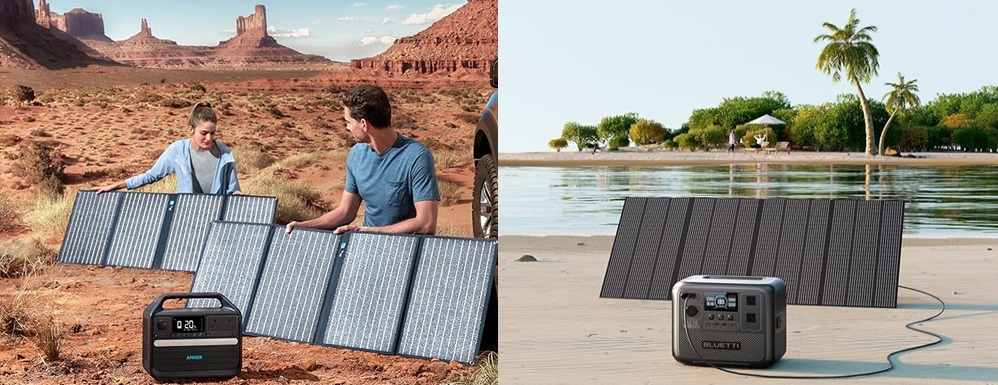
Within the realm of power banks, the standard range occupies the sweet spot – neither too small nor too large, making it well-suited to cater to the diverse needs of the majority. This optimal range ensures a balance between portability and capacity, providing users with a versatile solution to meet various power requirements.
| PREVIEW | PRODUCT | |

|
Anker 555 | See on Anker |
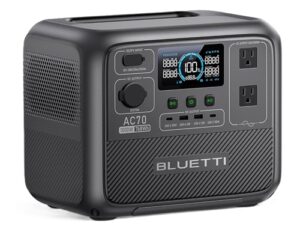
|
Bluetti EB3A | See on Bluetti |
What’s in the Box?
For the Anker 555:
- One Anker 555 portable power unit
- One AC adapter
- One car charger
- One user guide
Bluetti AC70:
- One Bluetti AC70
- An AC charging cable (2 parts: adapter plus charging cable)
- One solar charging cable
- One Car charging cable
- Grounding bolt
- Quick start guide
First Impression
The construction of the Bluetti AC70 showcases robust durability with a primary build of tough hard plastic, instilling a sense of confidence in its overall quality. Designed to be compact and user-friendly, it measures 12.4 x 8.2 x 10.1 inches and weighs 22.5 lbs/10kgs, making it a conveniently portable power station. Its thoughtful design incorporates an integrated handle at the back, enhancing maneuverability and enabling users to carry it effortlessly with just one hand.
Shifting our attention to the Anker PowerHouse 555, it opts for a straightforward, no-frills design that prioritizes simplicity and practicality. Measuring 8.2″L x 10.1″W x 12.4″H, it is also relatively compact, ensuring ease of use in various settings. The front of the unit features a high-quality LCD display, providing crucial information such as battery capacity, output power, and charging status. Additionally, a large built-in light on the front serves a dual purpose by illuminating a significant area, eliminating the need for an extra flashlight. This design choice reflects Anker’s commitment to delivering a user-friendly and efficient solution for diverse power needs.
| Anker 555 | Bluetti AC70 | |
| Weight | 29.8 lbs | 22.5 lbs |
| Size (LxWx H) | 13.78″L x 7.4″W x 11.61″H
inches |
8.2″L x 10.1″W x 12.4″H |
| Capacity | 1024Wh | 768Wh |
| USB-A Output | 5V⎓2.4A (2.4A Max Per Port) | 4 Ports: (2 ports with 5V, 3A each), (2 ports with 18W each) |
| USB-C Output | 5 Ports: 5V⎓3A/ 9V⎓3A/ 15V⎓3A/20V⎓3A/20V⎓5A (100W Max) | 1 Port: (60W Max) (5V/3A, 9V/3A, 12V/3A,15V/3A, 20V/3A) |
| Car Charger Output | 12V⎓10A | 2 Port: 11.5V-14.4V/23V-28.8V |
| AC Output
(Bypass Mode) |
2 Ports: 110V~ 9.09A, 50Hz/60Hz, 1000W | 6 x 120V (2000W Total) |
| Solar Recharge Time | 5.5 Hrs to 100% using 200W solar input | 500W Max solar power.
1.9 – 2.4 Hrs to full charge |
| AC Recharge Time | 4.1 Hrs to 100% using both USB-C port and in-box adapter | 0-80% in 45 min
0-100% in 1.5 Hours 4 Hours on wall charging |
Portability
As far as portability is concerned, the Anker PowerHouse 555 and Bluetti AC70 present distinct considerations for users. With a weight of 29.5 lbs, the Anker leans towards the heavier side compared to the Bluetti’s 22.5 lbs, making the latter a more lightweight option. The 7 lbs difference can be a noteworthy factor, especially for those prioritizing ease of transport. Both units, however, share the convenience of rigid handles designed for comfortable carrying.
Battery capacity & power
Undoubtedly, battery capacity and power stand as pivotal features when evaluating battery packs. In the comparison table, it’s evident that the Anker PowerHouse 555 boasts a slightly higher capacity at 1024Wh but falls short in battery power compared to the Bluetti AC70, which offers a robust 2000W. While the difference might not be substantial, the Bluetti’s 2000W power output provides a notable advantage, enabling it to power a greater number and variety of devices. Hence, users can benefit from Bluetti’s enhanced power lifting option, making it a compelling choice for those with diverse energy needs.
| Anker 555 | Bluetti AC70 | |
| Battery Capacity | 1024Wh | 768Wh |
| Battery Power | 1000W | 2000W |
Recharge times
Certainly, the recharge times for these two power stations are crucial considerations, as the speed of recharging significantly impacts their practicality. The table below provides a concise summary of the recharging durations for the Anker PowerHouse 555 and the Bluetti AC70:
| Anker 555 | Bluetti AC70 | |
| AC Adapter | 5.5 hrs with 200W solar input | 0-80% in 45 min
0-100% in 1.5 hrs using 950W AC input |
| Solar Recharge | 4.1 hrs or less (0% – 100%) using USB-C and in-box adapter | 2 hrs 0-100%
Uses upto 500W of solar power |
Analyzing the data, it becomes evident that the Bluetti AC70 outshines the Anker 555 in terms of recharge times. Notably, the Bluetti achieves a rapid 0-80% recharge in just 45 minutes, showcasing its efficiency. Additionally, the Bluetti’s 0-100% recharge using a 950W AC input takes only 1.5 hours, further emphasizing its superior recharging speed. Even in solar recharge, the Bluetti excels, taking just 2 hours to reach 0-100% with support for up to 500W of solar power. In comparison, the Anker 555’s recharge times are longer in every category, making the Bluetti a more time-efficient option for users seeking quicker turnaround times.
Verdict: Anker 555 vs Bluetti AC70 which one is better?
In the mid-range power station category, the Bluetti AC70 emerges as the superior choice, offering a winning combination of portability, battery power, and efficient recharge times. With a more manageable weight of 22.5 lbs and a thoughtful design, the Bluetti AC70 caters to users prioritizing ease of transport without compromising on power. Its 2000W power output provides a significant advantage over the Anker PowerHouse 555, allowing the Bluetti to meet a diverse range of energy needs, making it a compelling option for users seeking a versatile and efficient portable power station.
The Bluetti AC70’s impressive recharge times further solidify its position as the top contender in this category. Achieving a rapid 0-80% recharge in just 45 minutes and a 0-100% recharge in 1.5 hours using a 950W AC input, the Bluetti stands out as a time-efficient solution. Even in solar recharge, it outperforms the Anker 555, taking only 2 hours to reach 0-100% with support for up to 500W of solar power. While both units offer sturdy handles for easy carrying, the Bluetti AC70’s superior portability and performance make it the clear winner for users seeking a reliable and powerful mid-range portable power station.
4. High range – Anker F1500 vs Bluetti AC200P (around 2000W capacity)
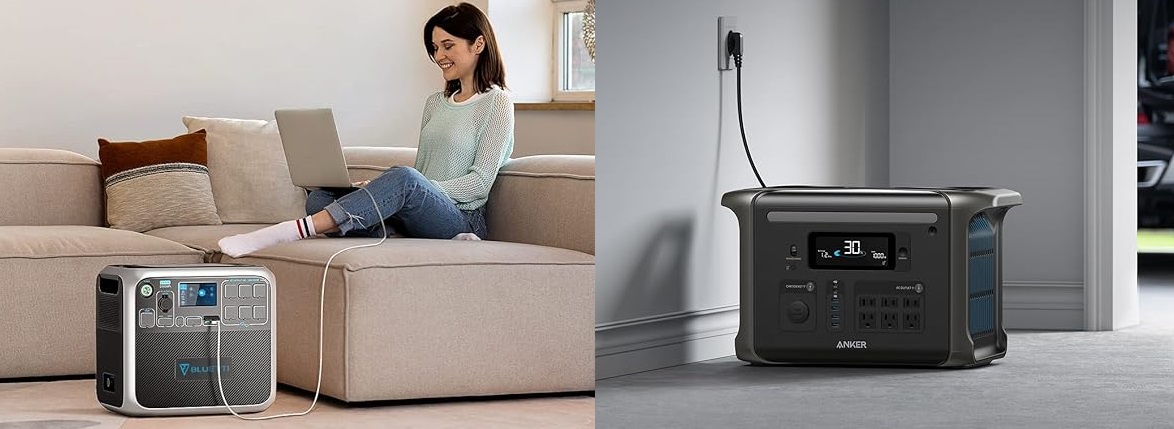
The Anker F1500 and Bluetti AC200P stand out as powerhouse units within their respective lineups, delivering ample power to meet a variety of energy needs. Positioned as robust investments, these two power stations cater to users seeking a higher level of potency compared to other options on this list.
| PREVIEW | PRODUCT | |
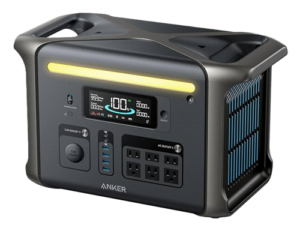 |
Anker F1500 | See on Anker |
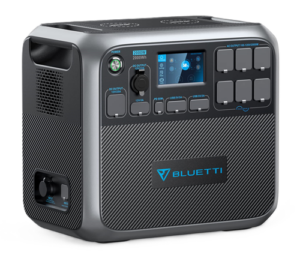 |
Bluetti AC200P | See on Bluetti |
What’s in the Box?
Anker F1500
- One Anker F1500 unit
- One AC power cable
- One solar power cable
- One car charging cable
- A welcome guide
Bluetti AC200P
- One Bluetti AC200P power station
- One solar charging cable
- An AC charging cable (2 parts: adapter and charging cable)
- One car charging cable
- One multi-functional aviation cable
- Warranty card
- QC certificate
- User manual
First Impression
Initial impressions of the Anker SOLIX F1200 reveal a device exuding rugged durability and intelligent design, making it an excellent choice for backup power in a home setting. Encased in a robust aluminum frame and enveloped in thick molded plastic, this powerhouse features two substantial handles, facilitating easy transportation around the house or shared carrying for camping expeditions.
On the other hand, the Bluetti AC200P arrives in an impressive, albeit weighty, 43kg package. The meticulous attention to packaging is evident, with a sturdy outer box featuring reinforced edges. Constructed from a combination of polycarbonate and flame-retardant ABS, the power station radiates toughness, although lacking a rubber bumper. Overall, the Bluetti AC200P boasts a resilient build, certainly befitting its high-power capabilities.
| Anker F1500 | Bluetti AC200P | |
| Weight | 43.87 lbs /19.8 kgs | 60.6 lbs |
| Size (LxWx H) | 18.23 x 9.33 x 11.34 inches | 16.5 x 11 x 15.2in / 42 x 28 x 38.65cm |
| Capacity | 1800Wh | 2000Wh |
| USB-A Output | 4 X 12W (Each) | 4 Ports: (2 ports with 5V, 3A each), (2 ports with 18W each) |
| USB-C Output | 1 X 100W / 1 x 60W | 1 Port: (60W Max) (5V/3A, 9V/3A, 12V/3A,15V/3A, 20V/3A) |
| Car Charger Output | 120W | 2 Port: 11.5V-14.4V/23V-28.8V |
| AC Output
(Bypass Mode) |
1000W | 6 x 120V (2000W Total) |
| AC Output (Inverter Mode) | 120V~20A, 60Hz, 2400W Max | 5 Ports: 4 ports 120V, 20A and 1 port 120V, 30A (2200W total max continuous, 4800W surge peak) |
| Solar Recharge Time | 3.6H to 100%(600W) | 2.5 Hours by Solar
Input max power 700W |
| AC Recharge Time | 1.4H to 80%, 2H 2 Min to 100% | 2.2H max charging power 500W |
Portability
In terms of portability, the Anker F1500 tips the scales at approximately 43.87 pounds, providing a manageable weight for on-the-go usage. On the other hand, the Bluetti AC200P weighs in at around 60.6 pounds. While both remain within the realm of portability, the Bluetti AC200P leans towards the heavier side, making the Anker F1500 the more lightweight and easily transportable option.
Battery capacity & power
In the realm of battery capacity and power, the Anker F1500 and Bluetti AC200P showcase distinct capabilities. The Anker F1500, with a capacity of 1536Wh, falls short in comparison to the Bluetti AC200P, which offers a more robust 2000Wh. The surge power further highlights the Bluetti AC200P’s dominance, surging to an impressive 4800 watts compared to the Anker F1500’s 2400W. This underscores the Bluetti AC200P as a powerhouse, excelling in both capacity and surge capabilities.
| Anker F1500 | Bluetti AC200P | |
| Battery Capacity | 1536Wh | 2000Wh |
| Battery Power | 1800W | 2000W |
| Surge Power | 2400W | 4800 watts |
Recharge times
The Anker F1500 requires a commendable 1.4 hours to reach 80% and a total of 2 hours and 2 minutes for a full 100% recharge at 1000W. Meanwhile, both the Anker F1500 and Bluetti AC200P achieve solar recharge within 3.6 hours, with Bluetti holding a slight edge with its 700W power support. However, Bluetti takes the efficiency game a step further by offering the option to use two AC adapters, reducing the recharge time to a notable 2.5 hours with a total input of 1000W.
Ultimately, the decision between the Anker F1500 and the Bluetti AC200P in terms of recharge times boils down to individual preferences and specific use cases. If there’s a convenient option to charge using an AC adapter, the Anker F1500 takes the lead with an impressive 2 hours and 2 minutes for a full recharge. However, for those relying on solar charging, the Bluetti AC200P offers an additional 100W input, providing an alternative that might appeal to eco-conscious users.
In essence, it’s a tie between the two power stations, and the choice depends on personal priorities. If time is of the essence and you have access to an AC power source, the Anker F1500 stands out. On the other hand, if you prioritize solar charging and don’t mind a slightly longer wait, the Bluetti AC200P becomes the preferred option. The tie underscores the importance of considering individual needs and charging scenarios, allowing users to make well-informed decision based on their preferences and practical requirements.
| Anker F1500 | Bluetti AC200P | |
| AC Adapter Input | 1.4H to 80%, 2H 2 Min to 100% (1000W) | 4.5 hours to 100%, input of 500W
2.5 hours with 1000W input using 2 AC adapters |
| Solar Recharge | 3.6H to 100%(600W) | 3-6 hours to 100% 700W input |
Verdict: Anker F1500 vs Bluetti AC200P which one is better?
In the high-range category, both the Anker F1500 and Bluetti AC200P showcase impressive capabilities, making them formidable choices for powering various devices. Upon closer examination, the Bluetti AC200P surges ahead, although the difference is not significantly pronounced compared to the Anker. Both power stations offer robust features, but Bluetti stands out as the preferable option for outdoor enthusiasts and those inclined towards solar charging.
Analyzing the details, the Bluetti AC200P boasts a larger battery capacity at 2000Wh, providing a substantial energy reservoir. In contrast, the Anker F1500, with a capacity of 1536Wh, lags behind in this aspect. The surge power of the Bluetti AC200P at 4800 watts is notably higher than the Anker F1500’s 2400W, demonstrating its superior capability to handle sudden energy spikes.
However, the difference in performance is not overwhelmingly significant, emphasizing the Anker F1500’s commendable standing in the high-range category. What tips the scale in favor of the Bluetti AC200P is its outdoor-friendly design and enhanced solar charging capabilities. With a weight of 60.6 pounds, the Bluetti AC200P remains manageable for on-the-go use, and its solar recharge time of 3-6 hours with 700W input makes it a practical choice for eco-conscious users.
In essence, both power stations are excellent options, but if outdoor use and efficient solar charging are top priorities, the Bluetti AC200P edges ahead. The decision ultimately hinges on individual preferences and specific use cases, ensuring users can make a well-informed choice based on their energy needs and intended applications
5. Top range – Anker Solix F2600 vs Bluetti AC200MAX
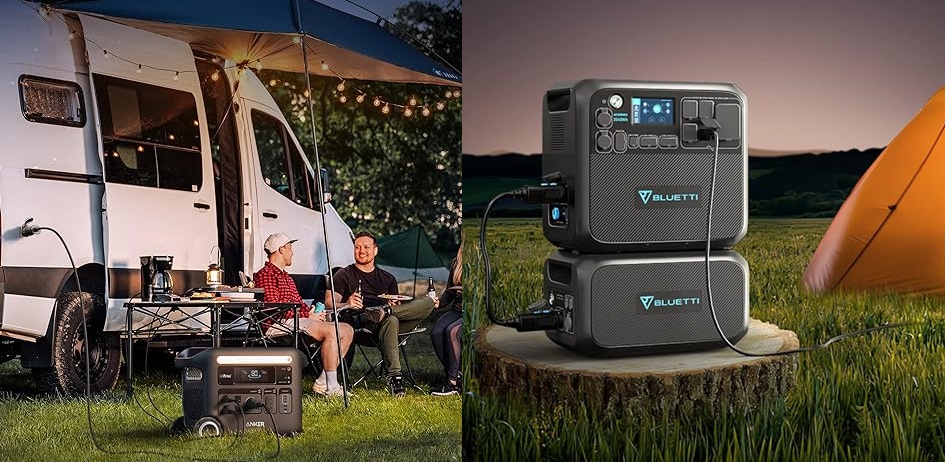
If you weren’t satisfied with the mid-range options, here’s the top range. Now, let’s dive into a category that promises even more power. In this segment, we’ll be exploring two of the most potent portable power stations featured on this list:
| PREVIEW | PRODUCT | |
 |
Anker Solix F2600 | See on Anker |
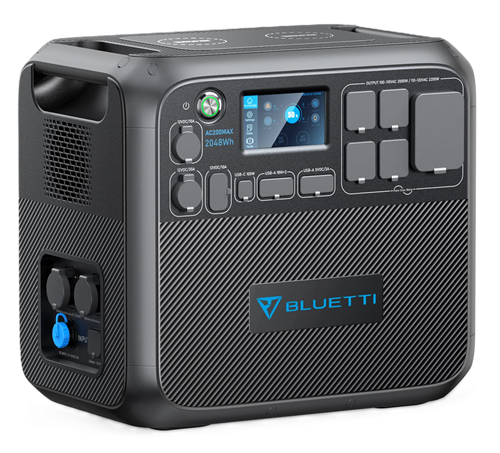
|
Bluetti AC200MAX | See on Bluetti |
What’s in the Box?
Anker Solix F2600
- AC charging cable
- car charging cable
- solar charging cable
- accessory bag
- user manual
Bluetti AC200Max:
- One Bluetti AC200Max power station
- One solar charging cable
- An AC charging cable (2 parts: adapter and charging cable)
- One car charging cable
- One multi-functional aviation cable
- Warranty card
- QC certificate
- User manual
First Impression
Upon the initial unboxing experience, it was evident that both of these power stations arrived in sizable and weighty packages. The Bluetti AC200MAX impressively tipped the scales at 61.9 lbs, closely followed by the Anker Solix F2600 at 67.24 lbs. Undoubtedly, such substantial weight is the trade-off for accommodating a power-packed, large capacity within these units.
Beyond the weight, a distinct industrial aesthetic permeated both power stations. Both the Bluetti AC200MAX and the Anker Solix F2600 exuded a sleek and minimalist design, featuring graphics that are subtle and unobtrusive. Personally, the preference tilted toward the Bluetti AC200MAX, thanks to its captivating black and ice blue theme. This not only enhanced its visual appeal but also contributed to an overall more appealing design, setting it apart in the realm of industrial-style power stations.
| Anker Solix F2600 | Bluetti AC200MAX | |
| Weight | 67.24 lbs | 61.9 lbs (28.1 kgs) |
| Size (LxWx H) | 20.67 x 9.84 x 15.55 inches | 16.5 x 11 x 15.2in / 42 x 28 x 38.65cm |
| USB-A Output | 120V~12A Max, 60Hz, 1440W Max | 4 Ports: (2 ports with 5V, 3A each), (2 ports with 18W each) |
| USB-C Output | 5V⎓3A/ 9V⎓3A/ 15V⎓3A/ 20V⎓3A 20V⎓5A (100W Max Per Port) | 1 Port: (100W Max) |
| Car Charger Output | 1 port: 12V=10A | 1 Port: 12V, 10A |
| AC Output
(Bypass Mode) |
120V~12A Max, 60Hz, 1440W Max | 2 Ports: 120V (1000W total max continuous, 1400W surge peak) |
| AC Output(Inverter Mode) | 120V~20A, 60Hz, 2400W Max | 5 Ports: 4 ports 120V, 20A and 1 port 120V, 30A (2200W total max continuous, 4800W surge peak) |
| Lifecycles | 3000 cycles to 80%+ capacity | 2,500 cycles to 80% original capacity |
| Information Display | Digital display (Has more information) | Digital display |
| Operating Temperature | -4°F-104°F / -20°C-40°C | -4°F-104°F / -20°C-40°C |
Portability
Portability is a key consideration in power station selection, and the weight of these units plays a significant role. The Bluetti AC200MAX, with a weight of 61.9 lbs, is notably lighter compared to the Anker Solix F2600, which weighs 67.24 lbs. Both power stations are equipped with built-in handles, enhancing their maneuverability. If ease of carrying is a top priority, opting for the Bluetti AC200MAX makes sense, given its lighter weight and the practicality of the built-in handles.
Despite their substantial weight, the inclusion of handles underscores the manufacturers’ focus on user convenience during transportation. These handles make it more manageable to move the power stations, easing the concern over their considerable weight. In the end, the choice between the Bluetti AC200MAX and the Anker Solix F2600 boils down to individual preferences, where those valuing a lighter load might find the Bluetti more appealing for on-the-go power needs.
Battery capacity & power
Battery capacity and power can be a bit counterintuitive at times. I used to believe that a heavier battery station equated to more capacity, but I was mistaken. In comparing the Anker Solix F2600 and the Bluetti AC200MAX, my assumption was challenged. The Anker Solix F2600 surprisingly boasts a larger weight and larger capacity of 2560Wh, while the Bluetti AC200MAX comes in slightly lower at 2048Wh. What’s even more unexpected is that both power stations share a similar continuous power output of 2200W, highlighting that while in this case it’s true, weight doesn’t always correlate directly with capacity or power.
| Anker Solix F2600 | Bluetti AC200MAX | |
| Battery Capacity | 2560Wh | 2048Wh |
| Battery Power | 2200W | 2200W |
| Surge Power | 3600W | 4800W |
The comparison chart further reveals that the Anker Solix F2600 surpasses the Bluetti AC200MAX in surge power, with 3600W compared to 4800W, adding another layer of complexity to the relationship between weight and power in these advanced power stations.
Recharge times
Recharge times turned out to be a surprising aspect that left me a bit disappointed. Initially, I anticipated that Bluetti might compensate for its lower capacity with quicker recharging times. However, the reality was quite different, as revealed in the comparison between the Anker Solix F2600 and the Bluetti AC200MAX. The Anker Solix F2600 showcased notably faster recharging times with an AC adapter, requiring just 1 hour and 40 minutes to reach 80%, compared to the Bluetti AC200MAX’s 5.5-6 hours at 400W. Even in solar recharge, where the expectation might be different, the Anker Solix F2600 again outperformed the Bluetti AC200MAX, taking 2 hours compared to the latter’s 3.0-3.5 hours at 900W. This unexpected revelation challenges assumptions about the relationship between capacity and recharging speed in power stations.
| Anker Solix F2600 | Bluetti AC200MAX | |
| AC Adapter | 1 hr 40 min (80%) | 5.5-6 hrs (400W) |
| Solar Recharge | 2 hrs | 3.0-3.5 hrs (900W) |
Verdict: Anker Solix F2600 vs Bluetti AC200MAX which one is better?
In the top-range category, the Anker Solix F2600 and Bluetti AC200MAX emerge as heavyweight contenders, both offering robust power solutions. The Anker Solix F2600, priced at $2199, boasts an impressive battery capacity of 2560Wh and a continuous power output of 2200W, with a surge power of 3600W. On the other hand, the Bluetti AC200MAX, priced at $1599, stands out with a substantial 4800W surge power, although it lags slightly behind in battery capacity at 2048Wh. The choice between these two behemoths involves a trade-off between higher surge power in the Bluetti AC200MAX and a larger overall battery capacity in the Anker Solix F2600.
When it comes to portability, the Bluetti AC200MAX takes the lead, weighing in at 61.9 lbs compared to the Anker Solix F2600’s 67.24 lbs. Both units incorporate built-in handles for improved maneuverability, but the Bluetti’s lighter weight enhances its appeal for those prioritizing ease of transportation. However, the verdict becomes nuanced as we consider recharge times. Surprisingly, the Anker Solix F2600 outperforms the Bluetti AC200MAX in recharging speed, emphasizing that assumptions about the relationship between capacity and recharge times may not always hold true. Ultimately, the decision between these two powerhouses hinges on individual preferences, with the Anker Solix F2600 excelling in recharge speed and the Bluetti AC200MAX offering a compelling combination of high surge power and better portability at a more economical price point.
Bluetti Vs Anker Power Station: In-depth Comparison

